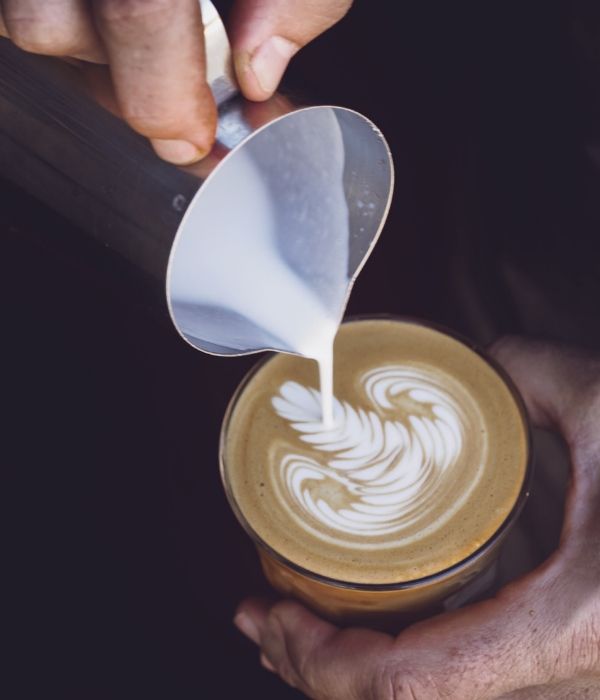Steamed and frothed milk are always going to be favorites when dealing with coffee. And learning how to steam and froth milk at home will save you a lot of trouble, and you'll be able to make your own lattes and cappuccinos.
There are several ways to do this at home, and I'm going to help you learn those.
Table of Contents
What's the difference between steaming and frothing milk ?
Steamed and frothed milk are basically the same thing, as in they are most often found together.
Both are hot milk, only steamed milk contains very, very small air bubbles (microfoam), which will lend it that creamy, silky texture we all love very much.
Frothed milk is usually the upper part of steamed milk, in that it has larger air bubbles that give the appearance if actual foam. You can make just frothed milk, without any microfoam. But most often you'll get both.
For example anything other than a steam wand on an espresso will never be able to lend you that microfoam. But you can get very close to it with other frothing methods.
Also, some recipes call for one or both of these heated milks.
A latte is largely steamed milk, with a fairly thin layer of frothed milk on top. This is what gives it that creamy, velvety texture
Alright, now that we've got that cleared up, let's see how you can steam and froth your milk in the comfort of your own home.
1. Steam and froth milk with an espresso's steam wand
This is probably the most obvious, but also the easiest way to properly steam and froth milk at home. As long as you've got an espresso machine with a wand, that is.
Please remember to run a shot of steam through the wand before you prepare the pitcher, to clean the wand on the inside.
The espresso steam wand will get you both steamed and frothed milk, depending on how you use it. You're going to need to pay very good attention to where and how long you keep the wand tip inside the milk.
Whatever you want to do with the milk (steamed or frothed), you'll need a pitcher that's got sides tall enough the milk won't spill over.
Make sure to only fill the container to ⅓ total capacity, to allow room for expansion and avoid any spilled milk.
Making steamed milk with an espresso steam wand
If steamed milk is what you're after, you're going to need to keep the want tip near the bottom of the pitched, completely submerged in the milk.
The hot steam will incorporate very small air bubbles into your milk, and heat it at the same time.
It's best to angle the tip of the wand towards the side of the pitcher, to create a sort of vortex/tornado effect, which will incorporate some air as well.
If you're using a lot of milk (and thus have a large pitcher) make sure to gently move the want up and down as well, to evenly heat all the milk, from the top layer tot he bottom one.
Once your milk is hot (should be around 140 F/60 C) you shouldn't allow it to get hotter, otherwise you'll get a different flavor in your milk.
The end result should be milk that's doubled in size, and it should have a creamy, velvety texture. This means that the air bubbles, being so very, very tiny probably won't be visible.
But they'll be there. You might also get froth on the top of the milk, which would be normal and nothing to be alarmed about. It's very hard to steam milk without frothing it.
Also, if you're an aspiring latte artist it's the steamed milk you should try and master, as this is what's going to be the bulk of the art.
Making frothed milk with an espresso steam wand
If you simply want frothed milk, this will be fairly easy, by comparison.
Instead of completely submerging the wand, only keep the tip just below the surface of the milk.
This will incorporate larger air bubbles into the milk. The closer to the surface the tip is, the larger the bubbles.
You will have to reach the bottom of the pitcher ever now and then to evenly heat the milk with the wand.
But as long as you keep the wand near the surface, you should get frothed, not steamed, milk.
When you're done frothing the milk, hit the side of the pitcher against the counter or something hard. This will knock out all the overly large air bubbles.
And if you want to be extra sure you've got even bubbles, swirl the milk inside the pitcher a couple of times.
2. Use a clean mason jar in the microwave to froth milk
What is you have no espresso machine to speak of ? Well then, there's still hope.
One way to do this is to use a mason jar, but really any clean, glass jar will do just fine. Courtesy of TheKitchn.com.
This method will not really yield microfoam, but it will get pretty close to it.
Not through texture, but through how thick the foam stabilizes.
You will need to use cold 2% or non-fat milk, and again only fill the jar ⅓. Screw the lid on, and shake like your latte depends on it.
It will take a couple of minutes, and you might just need some rest after it (it's a good upper arm workout, tho), but once you're done shaking the jar you should have some very, very frothy milk.
Take the lid off, and place it in the microwave. You'll need to microwave it for a few seconds at a time, as your might get colder or hotter pockets.
Re-shaking the foam is not a good idea, as you're going to ruin the already made structure.
Once the foam's been heated, it should be stable. This means you will be able to spoon it onto your coffee, and do whatever you like with it.
Please keep in mind you'll be left with some warm milk that hasn't foamed, on the bottom of the jar.
And also keep in mind that said milk can quickly overflow if you let it boil in the microwave (it happens tot he best of us).
3. Get a milk frother/wand to froth milk at home
If you're getting tired of shaking jars, or would like a method that can get you a smoother foam, then maybe a frother wand would be a good idea.
For those not familiar with the concept, it's a sort of whisk (very, very tiny) attached at the end of an automated wand. They usually run on batteries, and have a very long tip to submerge into a full coffee cup.
You can also use these things as a way to really quickly blend some drinks, and just whip up some lightly whipped cream in a small batch. Like for espresso con panna, for example.
If you have no milk frother/wand, check out this one.
It's a milk frother by Zulay, and it's one of the coolest looking ones I've ever seen. Of course, that says nothing about the quality, but looks are fairly important as well.
It's a standard frother, meaning it can handle milk and water, so thinner liquids. But you should never put it in something like honey or maple syrup, or other such liquids. Its power isn't that strong, no milk frother can do that.
The wand length is fairly long, so it will be able to properly foam the milk in any coffee cup you can imagine.
Comes with a nice stand to keep the wand on, and also serves as a sort of drying rack.
Easily rinsed under a jet of hot water in the sink. And it has a simple design, with just an on/off button.
You can check the listing on Amazon here, and read the reviews as well.
If you already have one at home, then you're going to want to (again) fill the pitcher only ⅓ of the way with warm milk.
Place the wand inside the milk, either close to the bottom for a creamier milk, or close to the top for a frothy one. And let it buzz away for a couple of minutes.
This will make the milk froth, and it's the closest thing you can get to microfoam without using an espresso steam wand.
As the bubbles on the top of the milk reach the density you like, keep lowering the wand. This will make sure you're close tot he surface of the actual milk, and not destroying the foamed milk.
This is because as the milk foam forms, it will take up the upper part of the milk, and you'll simply have to keep going lower if you want to froth the whole milk.
4. Use any sort of mixing method you know of
Alright, you have no espresso machine, no jars to speak of, and a frothing wand is our of the question.
What else can you do ? The first 3 methods are the most common, and will produce the most reliable results.
Very close to the way a barista would steam/froth a cup of milk.
You have a few options here. They all include something like an electric mixer, blender, balloon whisk, that you will use on hot (140 F/ 60 C) milk to beat it into a froth.
None of these will get you a very dense froth, because you need a very high speed in order to build the bubbles/incorporate air into the milk just right. But you're going to use them if you have nothing else left.
Your options are:
- electric mixer
- hand mixer
- blender
- hand blender
- balloon whisk
Whichever you use, you will need to get a pitcher with (again) just ⅓ hot milk. And whisk/mix/blend the daylights out of that milk until it reaches a froth level you're pleased with.
Note that if you decide to use the blender, you will of course have to pour the hot milk into the blender, put the lid on, and blitz it on high for half a minute.
This method gives you the smoothest froth of all the options mentioned in this part, but it's still not microfoam. It's going to be smoother because it's done at a very high speed.
You will also lose a fair amount of foam this way, since parts of it will stay behind between the blades and you'll have to drip the blender into the cup for about a minute to get all the foam out.
Another thing to be careful about, whichever method you use, is the milk splashing about. Especially the mixers, since they can and will throw milk all over the place if you don't use a tall pitcher, or don't cover the sides.
Tips on steaming and frothing milk at home
Alright, now you know how to froth and steam milk at home. Well, if you have no espresso machine then all you'll be able to do is froth the milk.
But if you so have an espresso machine you'll be able to both steam and froth the milk.
There are some general tips and tricks to be sure of when steaming milk and you should definitely know and remember them any time you want to steam/froth your own milk.
Use the freshest milk possible
The fresher the milk the better and more stable the foam. This is because when you really need in a steamed or frother milk is a high protein content.
It's the heated proteins inside of the ilk that make the bubbles form and keep their shape, and the more protein there is in your milk, the better your milk foam will end up.
And, as we all know, protein (especially animal based) breaks down very easily. If you've ever forgot a bit of milk on the bottom of a glass on the counter, and found it again half a day later, you'll know you can't drink it.
Protein goes bad fast, and this means you need to use very fresh milk.
UHT milk is okay, and so is freshly brought milk. As long as it's far from its expiration date, it's fine.
As for the fat content, I'm a fan of whole milk. I think it just gives milk that beautiful buttery taste and smell that i just love.
But, in the interest of steaming and frothing milk, the higher the fat content, the harder it is to form bubbles since the fat won't allow that.
Best to use 2% milk since it offers the best balance between creaminess and foam density.
Heat the milk as evenly as you can
Whenever you heat the milk, try and get it as even as possible.
This is because you're going to need an even temperature to assure that your foam will keep, and won't break apart after the first minute.
Colder milk will lose its foam/bubbles very fast, and this means you're going to make to make sure all your milk reaches 140 F/60 C in order to be hot enough to keep its bubbles.
Always allow about ⅔ room for the milk to expand
You probably know this already after reading the articles, but I ask you again to please make sure you only fill up 30% of the pitcher/ container with milk before steaming or frothing it.
Milk, like heavy cream and whipped cream and anything else into which you incorporate air, will double and triple in size.
This is something that you're going to need to allow for when calculating how much milk to use for your latter or cappuccino.
It also means that when you're making some of those 12 basic coffee drinks, you're going to need to take into account the amount of milk after steaming/frothing.
Even if the pitcher seems pretty much empty, be assured it won't be by the time you're done with the milk.
So please, if you'd like to keep the milk in the pitcher, leave more than half of it empty.
The frothed/steamed milk should not fizzle
After you're done steaming or frothing the milk, you will have a whole lot of air bubbles present in your milk. No wonder there.
But, unlike regular foam, it should be stable.
It should be the kind of foam that keeps it shape and structure for several minutes. All milk foam breaks up in the end, but it should be able to hold together for more than a couple of minutes.
This is very closely tied to how fast the air's been incorporated into the milk. So steamed milk (microfoam) should be more stable than simple froth.
It also has to do with the temperature of the milk. Hot milk at 140F/60 C will retain its foam easier than colder milk, because the very structure pf the protein within the milk is changed and it will hold together better.
So, in short, if you've just steamed your milk and you think it looks good, but it fizzles once you stop, then it probably needs more steaming.
Final thoughts
Steaming and frothing milk at home is both fun and strenuous. There's a lot of trial and error whenever you try to make something professional at home, and steamed milk is no exception.
However much you mess up the steaming and frothing, you'll always be left with hot, (at least partly) frothy milk that's going to make your latte all that more special.
If you want to know more about coffee or tea, feel free to check the related articles below. Who knows what else you might find ?








